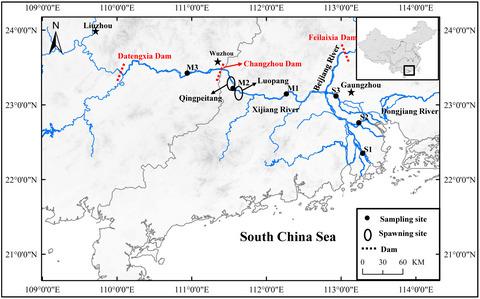当前位置:
X-MOL 学术
›
Ecol. Evol.
›
论文详情
Our official English website, www.x-mol.net, welcomes your
feedback! (Note: you will need to create a separate account there.)
The gut microbiome composition and degradation enzymes activity of black Amur bream (Megalobrama terminalis) in response to breeding migratory behavior
Ecology and Evolution ( IF 2.3 ) Pub Date : 2021-04-04 , DOI: 10.1002/ece3.7407 Yaqiu Liu 1, 2 , Xinhui Li 1, 2 , Jie Li 1, 2 , Weitao Chen 1, 2
Ecology and Evolution ( IF 2.3 ) Pub Date : 2021-04-04 , DOI: 10.1002/ece3.7407 Yaqiu Liu 1, 2 , Xinhui Li 1, 2 , Jie Li 1, 2 , Weitao Chen 1, 2
Affiliation

|
Black Amur bream (Megalobrama terminalis), a dominant species, resides in the Pearl River basin, known for its high plasticity in digestive ability. During spawning season, M. terminalis individuals with large body size and high fertility undergo a spawn migratory phase, while other smaller individuals prefer to settlement over migration. It is well known that gut microbial community often underpins the metabolic capability and regulates a wide variety of important functions in fish. However, little was known about how the gut microbiomes affect fish breeding migration. To investigate the variations in the gut microbiome of M. terminalis during the migration, we used high-throughput 16S rRNA gene sequencing to reveal the distinct composition and diversity of the whole gut microbiome of migrated and nonmigrated population during period of peak reproduction, respectively. Our results indicated that nonmigrated population in estuary had a higher alpha diversity than that of migrated population in main stem. Additionally, an obvious abundant taxa shift between the gut microbiota community of nonmigrated and migrated M. terminalis was also observed. Change of dominant gut taxa from nonmigrated to migrated population was thought to be closely related to their degradation enzymes. Our results suggested that amino acid metabolism and lipid metabolism in migrated population were higher than that in nonmigrated population, providing a line of evidence for that M. terminalis change from partial herbivorous to partial carnivorous diet during breeding migration. We further concluded that, in order to digest foods of higher nutrition to supply energy to spawning migration, M. terminalis regulate activities of the gut microbiome and degradation enzymes, considered to be a key physiological strategy for reproduction.
中文翻译:

黑鲷肠道微生物组成和降解酶活性对繁殖洄游行为的响应
黑鲷是珠江流域的优势种,以其消化能力可塑性强而闻名。在产卵季节,体型大、繁殖力高的终端巨蜥个体会经历产卵迁徙阶段,而其他较小的个体则更喜欢定居而不是迁徙。众所周知,肠道微生物群落通常支撑鱼类的代谢能力并调节多种重要功能。然而,人们对肠道微生物群如何影响鱼类繁殖迁徙知之甚少。为了研究终末霉菌在迁徙过程中肠道微生物组的变化,我们利用高通量16S rRNA基因测序分别揭示了迁徙种群和非迁徙种群在繁殖高峰期整个肠道微生物组的不同组成和多样性。我们的结果表明,河口非迁徙种群的α多样性高于主干迁徙种群。此外,还观察到非迁移和迁移的终末分枝杆菌的肠道微生物群落之间存在明显丰富的分类群变化。优势肠道类群从非迁移种群到迁移种群的变化被认为与其降解酶密切相关。我们的研究结果表明,迁徙种群的氨基酸代谢和脂质代谢高于非迁徙种群,为终末芒在繁殖迁徙过程中从部分草食性饮食向部分肉食性饮食的转变提供了证据。我们进一步得出结论, M.为了消化更高营养的食物,为产卵迁徙提供能量。 终末菌调节肠道微生物组和降解酶的活性,被认为是生殖的关键生理策略。
更新日期:2021-05-19
中文翻译:

黑鲷肠道微生物组成和降解酶活性对繁殖洄游行为的响应
黑鲷是珠江流域的优势种,以其消化能力可塑性强而闻名。在产卵季节,体型大、繁殖力高的终端巨蜥个体会经历产卵迁徙阶段,而其他较小的个体则更喜欢定居而不是迁徙。众所周知,肠道微生物群落通常支撑鱼类的代谢能力并调节多种重要功能。然而,人们对肠道微生物群如何影响鱼类繁殖迁徙知之甚少。为了研究终末霉菌在迁徙过程中肠道微生物组的变化,我们利用高通量16S rRNA基因测序分别揭示了迁徙种群和非迁徙种群在繁殖高峰期整个肠道微生物组的不同组成和多样性。我们的结果表明,河口非迁徙种群的α多样性高于主干迁徙种群。此外,还观察到非迁移和迁移的终末分枝杆菌的肠道微生物群落之间存在明显丰富的分类群变化。优势肠道类群从非迁移种群到迁移种群的变化被认为与其降解酶密切相关。我们的研究结果表明,迁徙种群的氨基酸代谢和脂质代谢高于非迁徙种群,为终末芒在繁殖迁徙过程中从部分草食性饮食向部分肉食性饮食的转变提供了证据。我们进一步得出结论, M.为了消化更高营养的食物,为产卵迁徙提供能量。 终末菌调节肠道微生物组和降解酶的活性,被认为是生殖的关键生理策略。











































 京公网安备 11010802027423号
京公网安备 11010802027423号